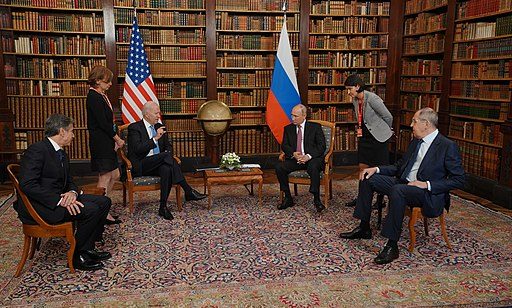
More than a year after the crisis in Ukraine erupted into violence, the Organization for Security and Co-operation in Europe (OSCE) continues to serve by default as the main international presence in-country. The Organization helped to broker two fragile ceasefire agreements (in September 2014 and February 2015), and oversees their implementation through an ambitious “Special Monitoring Mission (SMM),” which serves as the eyes and ears of the international community.
At a technical level, the OSCE’s efforts have been impressive. Following the fall of the Yanukovych regime, the 2014 Swiss Chairmanship moved swiftly to bring the conflict parties (including Russia) to the negotiating table, and to secure consensus on the launch of the SMM. The Mission, which began its deployment in March 2014, has done difficult, dangerous work, often in harsh conditions, and has gradually established itself as a credible stabilizing force. In a conflict where propaganda and disinformation have flown more freely than artillery shells, the SMM’s sober, factual reporting has been an invaluable asset to would-be peacemakers. At key moments – the battle for Sloviansk, the mass killing in Odessa, the downing of MH-17, the siege of Debaltseve – OSCE monitors have played key roles in sorting through conflicting reports, facilitating international assistance, and raising awareness of potential points of escalation.
The success of the SMM owes much to the political, financial and personnel support of the participating States: the Mission currently boasts an annual budget of some EUR 89m, making it easily the Organization’s largest fund, and it remains a draw for capable, dedicated individuals. The rapidity and smoothness of its deployment, and its adaptability as circumstances have evolved, also owe much to streamlined recruitment, financial management and security procedures adopted in the aftermath of the 2008 war in Georgia and 2010 crises in Kyrgyzstan. Long proud of its reputation for delivering a high return on investment relative to other international actors, the OSCE in recent years has emerged as a lean and efficient structure that excels at doing more with less.
Also praiseworthy is the extent to which the OSCE’s Participating States (including Ukraine) have mobilized other OSCE tools to complement the SMM’s efforts. [1] Even before the deployment of permanent monitors, Ukraine used the Vienna Document to invite representatives of OSCE participating States to inspect the conflict zone, providing much-needed transparency (and exposing those areas that remained inaccessible). The OSCE Project Coordinator in Ukraine responded quickly and effectively to Ukraine’s requests for dramatically expanded project activities, while the Organization’s specialized institutions (High Commissioner on National Minorities, Representative on Freedom of the Media and Office of Democratic Institutions and Human Rights) have been diligent in monitoring issues of concern and providing assistance to the new authorities in Kyiv within their respective mandates. ODIHR’s massive support for early presidential and parliamentary elections helped the new authorities in Kyiv strengthen their democratic legitimacy following the chaotic departure of President Yanukovych.
Of course, skeptics will point to the fact that for all of this activity, the OSCE has not ended the violence, prevented Russia’s annexation of Crimea, or slowed the advance of Russian-backed separatists in Donbas. Rather than making progress toward the resolution of the conflict, this line of argument goes, the OSCE is simply managing the status quo, in effect institutionalizing yet another “frozen conflict.” Indeed, these are legitimate criticisms – but not of the dedicated women and men carrying out the OSCE’s mandates, rather of the participating States who gave them those mandates.
In looking toward the future, this is the real question: not “what can the OSCE do?”, but rather “how can the U.S., the EU, Ukraine, Russia and other key actors best use the tools and the forum that the OSCE provides?” The SMM, the Project Coordinator and the institutions have performed well. Whether they will be able to do more ultimately depends upon the willingness of the conflict parties to support their efforts, and the level of political and material support those efforts receive from the wider OSCE community.
From the very beginning, the crisis in Ukraine has exposed both the continued need for a robust OSCE and the degree to which the participating States had stopped believing that such an Organization was achievable. In retrospect, the 20th Ministerial Council in Kyiv (December 5-6, 2013) might have provided the last best opportunity to resolve the Ukraine crisis peacefully. Yet Ministers, long accustomed to relegating the OSCE to clearly defined niches (election observation, media freedom, border monitoring) largely ignored the gathering storm on their doorstep. Key actors, such as U.S. Secretary of State John Kerry, EU High Representative for Foreign Affairs Catherine Ashton, and (remarkably) President Yanukovych himself, stayed away entirely. While 2014 brought the Organization back into the spotlight (due in large part to the energetic efforts of the Swiss Chairmanship), participating States can and must do better.
Fans of the OSCE often point to the Organization’s strength as a “first responder,” able to deploy rapidly as a stopgap while larger, better resourced actors muster their forces. Yet in Georgia, in Kyrgyzstan, and now in Ukraine – all states without access to EU bailouts or NATO Article 5 guarantees – the OSCE’s real value has been as a last resort, stepping in to fill gaps when there was no obvious way for others to do so. While the Organization’s efforts in such crises have not always been uniformly successful, the choice for the Euro-Atlantic/Eurasian community has often been between OSCE action and no action at all. Strengthening the OSCE’s efforts, not just to mitigate but ultimately to resolve the conflict in Ukraine, and the Organization’s ability to cope with the next such crisis, can make us all more secure.
[1] For a timeline of OSCE efforts, click here.
The opinions articulated above represent the views of the author(s), and do not necessarily reflect the position of the European Leadership Network or any of its members, the United States Government, or the OSCE. The ELN’s aim is to encourage debates that will help develop Europe’s capacity to address the pressing foreign, defence, and security challenges of our time.



